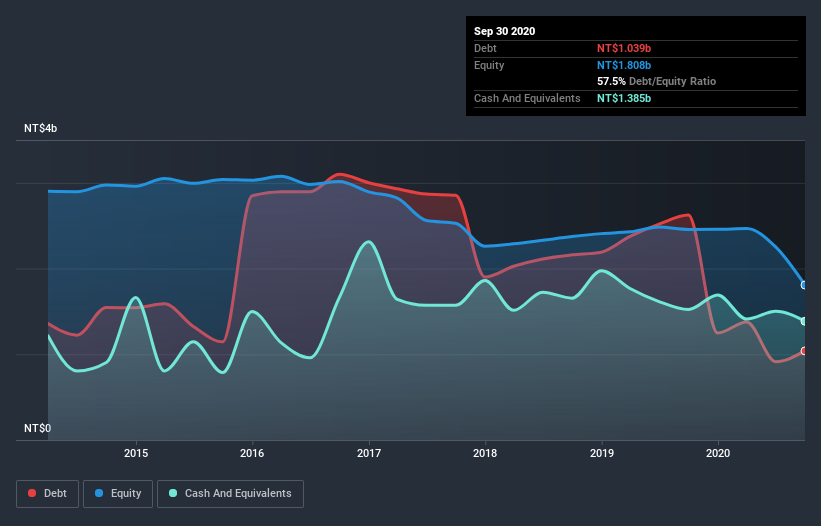- Taiwan
- /
- Construction
- /
- TWSE:2516
Health Check: How Prudently Does New Asia Construction & Development (TPE:2516) Use Debt?

Howard Marks put it nicely when he said that, rather than worrying about share price volatility, 'The possibility of permanent loss is the risk I worry about... and every practical investor I know worries about.' So it seems the smart money knows that debt - which is usually involved in bankruptcies - is a very important factor, when you assess how risky a company is. As with many other companies New Asia Construction & Development Corp. (TPE:2516) makes use of debt. But should shareholders be worried about its use of debt?
What Risk Does Debt Bring?
Generally speaking, debt only becomes a real problem when a company can't easily pay it off, either by raising capital or with its own cash flow. If things get really bad, the lenders can take control of the business. However, a more frequent (but still costly) occurrence is where a company must issue shares at bargain-basement prices, permanently diluting shareholders, just to shore up its balance sheet. Having said that, the most common situation is where a company manages its debt reasonably well - and to its own advantage. When we think about a company's use of debt, we first look at cash and debt together.
Check out our latest analysis for New Asia Construction & Development
How Much Debt Does New Asia Construction & Development Carry?
The image below, which you can click on for greater detail, shows that New Asia Construction & Development had debt of NT$1.04b at the end of September 2020, a reduction from NT$2.62b over a year. However, its balance sheet shows it holds NT$1.39b in cash, so it actually has NT$346.1m net cash.

A Look At New Asia Construction & Development's Liabilities
Zooming in on the latest balance sheet data, we can see that New Asia Construction & Development had liabilities of NT$4.18b due within 12 months and liabilities of NT$55.8m due beyond that. Offsetting these obligations, it had cash of NT$1.39b as well as receivables valued at NT$1.38b due within 12 months. So it has liabilities totalling NT$1.47b more than its cash and near-term receivables, combined.
Given this deficit is actually higher than the company's market capitalization of NT$1.08b, we think shareholders really should watch New Asia Construction & Development's debt levels, like a parent watching their child ride a bike for the first time. Hypothetically, extremely heavy dilution would be required if the company were forced to pay down its liabilities by raising capital at the current share price. Given that New Asia Construction & Development has more cash than debt, we're pretty confident it can handle its debt, despite the fact that it has a lot of liabilities in total. There's no doubt that we learn most about debt from the balance sheet. But it is New Asia Construction & Development's earnings that will influence how the balance sheet holds up in the future. So if you're keen to discover more about its earnings, it might be worth checking out this graph of its long term earnings trend.
In the last year New Asia Construction & Development had a loss before interest and tax, and actually shrunk its revenue by 14%, to NT$6.5b. That's not what we would hope to see.
So How Risky Is New Asia Construction & Development?
While New Asia Construction & Development lost money on an earnings before interest and tax (EBIT) level, it actually generated positive free cash flow NT$622m. So although it is loss-making, it doesn't seem to have too much near-term balance sheet risk, keeping in mind the net cash. Given the lack of transparency around future revenue (and cashflow), we're nervous about this one, until it makes its first big sales. To us, it is a high risk play. There's no doubt that we learn most about debt from the balance sheet. However, not all investment risk resides within the balance sheet - far from it. For instance, we've identified 2 warning signs for New Asia Construction & Development (1 is concerning) you should be aware of.
If you're interested in investing in businesses that can grow profits without the burden of debt, then check out this free list of growing businesses that have net cash on the balance sheet.
When trading New Asia Construction & Development or any other investment, use the platform considered by many to be the Professional's Gateway to the Worlds Market, Interactive Brokers. You get the lowest-cost* trading on stocks, options, futures, forex, bonds and funds worldwide from a single integrated account. Promoted
Valuation is complex, but we're here to simplify it.
Discover if New Asia Construction & Development might be undervalued or overvalued with our detailed analysis, featuring fair value estimates, potential risks, dividends, insider trades, and its financial condition.
Access Free AnalysisThis article by Simply Wall St is general in nature. It does not constitute a recommendation to buy or sell any stock, and does not take account of your objectives, or your financial situation. We aim to bring you long-term focused analysis driven by fundamental data. Note that our analysis may not factor in the latest price-sensitive company announcements or qualitative material. Simply Wall St has no position in any stocks mentioned.
*Interactive Brokers Rated Lowest Cost Broker by StockBrokers.com Annual Online Review 2020
Have feedback on this article? Concerned about the content? Get in touch with us directly. Alternatively, email editorial-team (at) simplywallst.com.
About TWSE:2516
New Asia Construction & Development
Provides public construction services for governments in Taiwan.
Proven track record with adequate balance sheet.
Market Insights
Community Narratives



